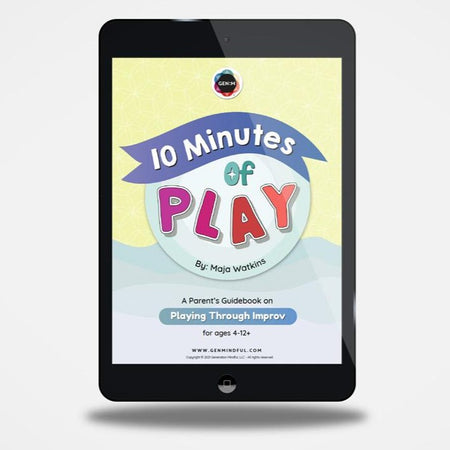By Maja Watkins
“I want the firetruck!” he wailed.
Sam was dug in and not budging. He had spent the majority of his early life in the hospital due to hydrocephalus, and he had a rockstar team dedicated to helping him overcome his medical challenges. Now, he was ready for a new venture: preschool.
I was studying child development and building a non-profit, Zip Zap Zop Enrichment , that teaches improvisational games to help nurture social-emotional learning in children. That’s when I met Sam. I was his shadow as he entered preschool. Because Sam was used to getting what he wanted when it came to toys and treats, which was his parent’s loving attempt to balance the hard days at the hospital, it was a challenge for him to interact with his peers … to notice, name, and process his emotions in the face of other’s desires, wants, and needs.
This made play hard. It had to go Sam’s way or he became upset, yelling out, hitting, and kicking. Witnessing this became the inspiration for a new improv game. To improvise or to “improv” is to stay flexible and “go with the flow” with whatever curveball is thrown our way, which was the exact skills I wanted to help nurture within Sam. Thus, the improv game “Gift Exchange” was born.
I called Sam’s class into a circle on the classroom carpet and taught them the new improv game. I watched their eyes light up in excitement and curiosity when I demonstrated how to play:
- A child gives an imaginary gift to their peer. This gift can be anything; something desirable like ice cream or a treasure chest or something less desirable like a dirty sock or toothbrush.
- The child who received the gift then acts as appreciative as possible for their gift - no matter if it was a treasure chest or a dirty sock. In doing so, it helps bolster the skill of “going with the flow.”
- The child who received the gift then tells their peer how they will use the gift. “I will use the dirty sock to make a sock puppet.”
- Then, it’s time to switch roles.
How did Sam do when the game was introduced to his class? Well … he struggled. Each time a child in the circle received a gift, Sam would say, “I want my gift to be a fire truck.” But when it rolled around to his turn, he got a pair of socks instead. His upset for not receiving what he wanted came out of his little body as a big yell.
But we kept at it.
I added a new element of improvisation to the game by saying “new choice” (a common improv comedy term) to some of the children who were flexible with their ideas. Each time I said “new choice” to a child, they were to, on the spot, change the gift they gave to their peer. So, if they had gifted sunglasses and I said “new choice”, the child would then come up with something new like a hairbrush. I also found the addition of “new choice” helpful in redirecting inappropriate words or potty humor. In doing this, it highlighted the behavior I did desire (picking a new, appropriate word), and strengthened their brain muscles responsible for creativity and communication.
While it may have been hard for him to want and not receive, I saw Sam watching and listening intensely as his peers modeled and played the game. When it was Sam’s turn for the second round, he was given a bowl of spaghetti by the child before him. This time, Sam said, “Thank you. I am going to go eat this spaghetti in my fire truck.”
Sam used his imagination instead of getting hung up on the gift he was given in the game (Woot!). This is a classic moment of “going with the flow” and using improv to practice this important life skill. Without knowing it, Sam gave a “yes, and” response, which is common in the improv world. A “yes, and” response means that we accept what the other improviser initiates, agreeing and adding to it. Had Sam simply said, “No!” when given spaghetti, the conversation would have been over, but, since he agreed to it and added on, the game continued. The ability to listen and add on ideas with others will help Sam in many areas of his life wherever communication and collaboration are needed whether it be a school project, imaginary play outside, or within friendships and other relationships.
While this game was challenging for Sam, it was so beneficial for him because it allowed him to practice the skills that were hard for him, namely receiving and responding to items or situations that may not be what he wanted or desired. Like all skills, the best way to strengthen them is to practice them. And what better way to practice a skill for a child than through play? It is actually how their brain is wired to learn. When we speak their learning language, we make it safe to grow new skills.
While I may have helped Sam, it was he who taught me that a simple improv game could help create a safe space to practice and develop skills that enhance friendships and socialization, unlike any other tool I had seen before with children. I truly believe social skills need to be felt not taught and improv games allow real, in-the-moment situations to occur that activate the brain. These improv games allow us to make mistakes and use our voices while laughing and having fun!
Grab our e-book full of games that bolster social-emotional learning in children (and adults, too)!
Grab Your 10 Minutes of Play For 10 Days!


















